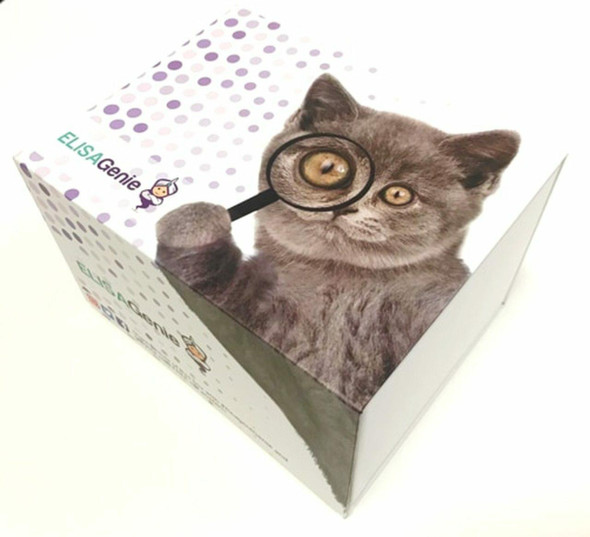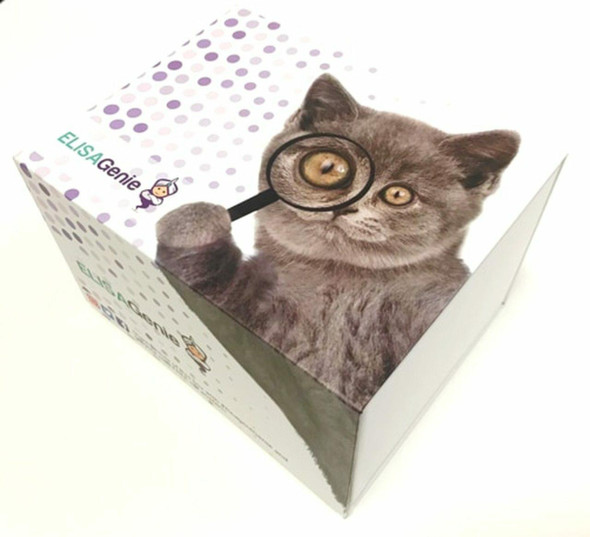Human ABCC6 / MRP6 ELISA Kit
- SKU:
- HUFI00910
- Product Type:
- ELISA Kit
- Size:
- 96 Assays
- Uniprot:
- O95255
- Sensitivity:
- 46.875pg/ml
- Range:
- 78.125-5000pg/ml
- ELISA Type:
- Sandwich
- Synonyms:
- ABCC6, Multidrug resistance-associated protein 6, MOAT-E, Multi-specific organic anion transporter E, ATP-binding cassette sub-family C member 6, Anthracycline resistance-associated protein
- Reactivity:
- Human
- Research Area:
- Signal Transduction
Description
Human ABCC6/MRP6 ELISA Kit
The Human ABCC6 (MRP6) ELISA Kit is specifically designed for the quantitative measurement of ABCC6 levels in human serum, plasma, and cell culture supernatants. This kit provides exceptional sensitivity and specificity, enabling precise and consistent results for various research applications.ABCC6, also known as Multidrug Resistance-Associated Protein 6 (MRP6), is a transporter protein that plays a crucial role in transporting various molecules across cell membranes. Dysfunction of ABCC6 has been linked to a rare genetic disorder called pseudoxanthoma elasticum (PXE), characterized by mineralization of elastic fibers in tissues throughout the body.
By accurately measuring ABCC6 levels, researchers can gain insights into the pathophysiology of PXE and explore potential therapeutic interventions for this debilitating condition. The Human ABCC6 (MRP6) ELISA Kit is an essential tool for studying ABCC6 biology and advancing research in related fields.
| Product Name: | Human ABCC6 / MRP6 ELISA Kit |
| Product Code: | HUFI00910 |
| Size: | 96 Assays |
| Alias: | ABCC6, Multidrug resistance-associated protein 6, MOAT-E, Multi-specific organic anion transporter E, ATP-binding cassette sub-family C member 6, Anthracycline resistance-associated protein |
| Detection method: | Sandwich ELISA, Double Antibody |
| Application: | This immunoassay kit allows for the in vitro quantitative determination of Human ABCC6 concentrations in serum plasma and other biological fluids. |
| Sensitivity: | 46.875pg/ml |
| Range: | 78.125-5000pg/ml |
| Storage: | 4°C for 6 months |
| Note: | For Research Use Only |
| Recovery: | Matrices listed below were spiked with certain level of Human ABCC6 and the recovery rates were calculated by comparing the measured value to the expected amount of Human ABCC6 in samples. | ||||||||||||||||
| |||||||||||||||||
| Linearity: | The linearity of the kit was assayed by testing samples spiked with appropriate concentration of Human ABCC6 and their serial dilutions. The results were demonstrated by the percentage of calculated concentration to the expected. | ||||||||||||||||
| |||||||||||||||||
| CV(%): | Intra-Assay: CV<8% Inter-Assay: CV<10% |
| Component | Quantity | Storage |
| ELISA Microplate (Dismountable) | 8×12 strips | 4°C for 6 months |
| Lyophilized Standard | 2 | 4°C/-20°C |
| Sample/Standard Dilution Buffer | 20ml | 4°C |
| Biotin-labeled Antibody(Concentrated) | 120ul | 4°C (Protect from light) |
| Antibody Dilution Buffer | 10ml | 4°C |
| HRP-Streptavidin Conjugate(SABC) | 120ul | 4°C (Protect from light) |
| SABC Dilution Buffer | 10ml | 4°C |
| TMB Substrate | 10ml | 4°C (Protect from light) |
| Stop Solution | 10ml | 4°C |
| Wash Buffer(25X) | 30ml | 4°C |
| Plate Sealer | 5 | - |
Other materials and equipment required:
- Microplate reader with 450 nm wavelength filter
- Multichannel Pipette, Pipette, microcentrifuge tubes and disposable pipette tips
- Incubator
- Deionized or distilled water
- Absorbent paper
- Buffer resevoir
| Uniprot | O95255 |
| UniProt Protein Function: | ABCC6: May participate directly in the active transport of drugs into subcellular organelles or influence drug distribution indirectly. Transports glutathione conjugates as leukotriene-c4 (LTC4) and N-ethylmaleimide S-glutathione (NEM-GS). Defects in ABCC6 are the cause of pseudoxanthoma elasticum (PXE). PXE is a disorder characterized by calcification of elastic fibers in skin, arteries and retina that results in dermal lesions with associated laxity and loss of elasticity, arterial insufficiency and retinal hemorrhages leading to macular degeneration. PXE is caused in the overwhelming majority of cases by homozygous or compound heterozygous mutations in the ABCC6 gene (autosomal recessive PXE). Individuals carrying heterozygous mutations express limited manifestations of the pseudoxanthoma elasticum phenotype (autosomal dominant PXE). Defects in ABCC6 are the cause of arterial calcification of infancy, generalized, type 2 (GACI2). GACI2 is a severe autosomal recessive disorder characterized by calcification of the internal elastic lamina of muscular arteries and stenosis due to myointimal proliferation. The disorder is often fatal within the first 6 months of life because of myocardial ischemia resulting in refractory heart failure. Belongs to the ABC transporter superfamily. ABCC family. Conjugate transporter (TC 3.A.1.208) subfamily. |
| UniProt Protein Details: | Protein type:Hydrolase; Membrane protein, integral; Membrane protein, multi-pass; Transporter; Transporter, ABC family Chromosomal Location of Human Ortholog: 16p13.11 Cellular Component: nucleus; plasma membrane Molecular Function:anion transmembrane-transporting ATPase activity; ATPase activity, coupled to transmembrane movement of substances; transporter activity Biological Process: response to drug; transmembrane transport; transport Disease: Arterial Calcification, Generalized, Of Infancy, 2; Pseudoxanthoma Elasticum; Pseudoxanthoma Elasticum, Forme Fruste |
| NCBI Summary: | The protein encoded by this gene is a member of the superfamily of ATP-binding cassette (ABC) transporters. ABC proteins transport various molecules across extra- and intra-cellular membranes. ABC genes are divided into seven distinct subfamilies (ABC1, MDR/TAP, MRP, ALD, OABP, GCN20, White). The encoded protein, a member of the MRP subfamily, is involved in multi-drug resistance. Mutations in this gene cause pseudoxanthoma elasticum. Alternatively spliced transcript variants that encode different proteins have been described for this gene. [provided by RefSeq, Jul 2008] |
| UniProt Code: | O95255 |
| NCBI GenInfo Identifier: | 118582251 |
| NCBI Gene ID: | 368 |
| NCBI Accession: | NP_001072996.1 |
| UniProt Secondary Accession: | O95255,P78420, Q8TCY8, Q9UMZ7, A2RRN8, A8KIG6, A8Y988 E7ESW8, |
| UniProt Related Accession: | O95255 |
| Molecular Weight: | 165 kDa |
| NCBI Full Name: | URG7 protein isoform 2 |
| NCBI Synonym Full Names: | ATP binding cassette subfamily C member 6 |
| NCBI Official Symbol: | ABCC6 |
| NCBI Official Synonym Symbols: | ARA; PXE; MLP1; MRP6; PXE1; URG7; ABC34; GACI2; MOATE; MOAT-E; EST349056 |
| NCBI Protein Information: | multidrug resistance-associated protein 6; URG7 protein |
| UniProt Protein Name: | Multidrug resistance-associated protein 6 |
| UniProt Synonym Protein Names: | ATP-binding cassette sub-family C member 6; Anthracycline resistance-associated protein; Multi-specific organic anion transporter E; MOAT-E |
| UniProt Gene Name: | ABCC6 |
*Note: Protocols are specific to each batch/lot. For the correct instructions please follow the protocol included in your kit.
Before adding to wells, equilibrate the SABC working solution and TMB substrate for at least 30 min at 37°C. When diluting samples and reagents, they must be mixed completely and evenly. It is recommended to plot a standard curve for each test.
| Step | Protocol |
| 1. | Set standard, test sample and control (zero) wells on the pre-coated plate respectively, and then, record their positions. It is recommended to measure each standard and sample in duplicate. Wash plate 2 times before adding standard, sample and control (zero) wells! |
| 2. | Aliquot 0.1ml standard solutions into the standard wells. |
| 3. | Add 0.1 ml of Sample / Standard dilution buffer into the control (zero) well. |
| 4. | Add 0.1 ml of properly diluted sample ( Human serum, plasma, tissue homogenates and other biological fluids.) into test sample wells. |
| 5. | Seal the plate with a cover and incubate at 37 °C for 90 min. |
| 6. | Remove the cover and discard the plate content, clap the plate on the absorbent filter papers or other absorbent material. Do NOT let the wells completely dry at any time. Wash plate X2. |
| 7. | Add 0.1 ml of Biotin- detection antibody working solution into the above wells (standard, test sample & zero wells). Add the solution at the bottom of each well without touching the side wall. |
| 8. | Seal the plate with a cover and incubate at 37°C for 60 min. |
| 9. | Remove the cover, and wash plate 3 times with Wash buffer. Let wash buffer rest in wells for 1 min between each wash. |
| 10. | Add 0.1 ml of SABC working solution into each well, cover the plate and incubate at 37°C for 30 min. |
| 11. | Remove the cover and wash plate 5 times with Wash buffer, and each time let the wash buffer stay in the wells for 1-2 min. |
| 12. | Add 90 µl of TMB substrate into each well, cover the plate and incubate at 37°C in dark within 10-20 min. (Note: This incubation time is for reference use only, the optimal time should be determined by end user.) And the shades of blue can be seen in the first 3-4 wells (with most concentrated standard solutions), the other wells show no obvious color. |
| 13. | Add 50 µl of Stop solution into each well and mix thoroughly. The color changes into yellow immediately. |
| 14. | Read the O.D. absorbance at 450 nm in a microplate reader immediately after adding the stop solution. |
When carrying out an ELISA assay it is important to prepare your samples in order to achieve the best possible results. Below we have a list of procedures for the preparation of samples for different sample types.
| Sample Type | Protocol |
| Serum | If using serum separator tubes, allow samples to clot for 30 minutes at room temperature. Centrifuge for 10 minutes at 1,000x g. Collect the serum fraction and assay promptly or aliquot and store the samples at -80°C. Avoid multiple freeze-thaw cycles. If serum separator tubes are not being used, allow samples to clot overnight at 2-8°C. Centrifuge for 10 minutes at 1,000x g. Remove serum and assay promptly or aliquot and store the samples at -80°C. Avoid multiple freeze-thaw cycles. |
| Plasma | Collect plasma using EDTA or heparin as an anticoagulant. Centrifuge samples at 4°C for 15 mins at 1000 × g within 30 mins of collection. Collect the plasma fraction and assay promptly or aliquot and store the samples at -80°C. Avoid multiple freeze-thaw cycles. Note: Over haemolysed samples are not suitable for use with this kit. |
| Urine & Cerebrospinal Fluid | Collect the urine (mid-stream) in a sterile container, centrifuge for 20 mins at 2000-3000 rpm. Remove supernatant and assay immediately. If any precipitation is detected, repeat the centrifugation step. A similar protocol can be used for cerebrospinal fluid. |
| Cell culture supernatant | Collect the cell culture media by pipette, followed by centrifugation at 4°C for 20 mins at 1500 rpm. Collect the clear supernatant and assay immediately. |
| Cell lysates | Solubilize cells in lysis buffer and allow to sit on ice for 30 minutes. Centrifuge tubes at 14,000 x g for 5 minutes to remove insoluble material. Aliquot the supernatant into a new tube and discard the remaining whole cell extract. Quantify total protein concentration using a total protein assay. Assay immediately or aliquot and store at ≤ -20 °C. |
| Tissue homogenates | The preparation of tissue homogenates will vary depending upon tissue type. Rinse tissue with 1X PBS to remove excess blood & homogenize in 20ml of 1X PBS (including protease inhibitors) and store overnight at ≤ -20°C. Two freeze-thaw cycles are required to break the cell membranes. To further disrupt the cell membranes you can sonicate the samples. Centrifuge homogenates for 5 mins at 5000xg. Remove the supernatant and assay immediately or aliquot and store at -20°C or -80°C. |
| Tissue lysates | Rinse tissue with PBS, cut into 1-2 mm pieces, and homogenize with a tissue homogenizer in PBS. Add an equal volume of RIPA buffer containing protease inhibitors and lyse tissues at room temperature for 30 minutes with gentle agitation. Centrifuge to remove debris. Quantify total protein concentration using a total protein assay. Assay immediately or aliquot and store at ≤ -20 °C. |
| Breast Milk | Collect milk samples and centrifuge at 10,000 x g for 60 min at 4°C. Aliquot the supernatant and assay. For long term use, store samples at -80°C. Minimize freeze/thaw cycles. |






